Human Trafficking Statistics in Ohio: Past, Present and Future
Ohio doubled the number of human trafficking task forces within the state. This means that as time goes on, more victims will find their freedom and more abusers will go to prison. To understand the full picture, you need to understand human trafficking-related events in Ohio over the last four years.
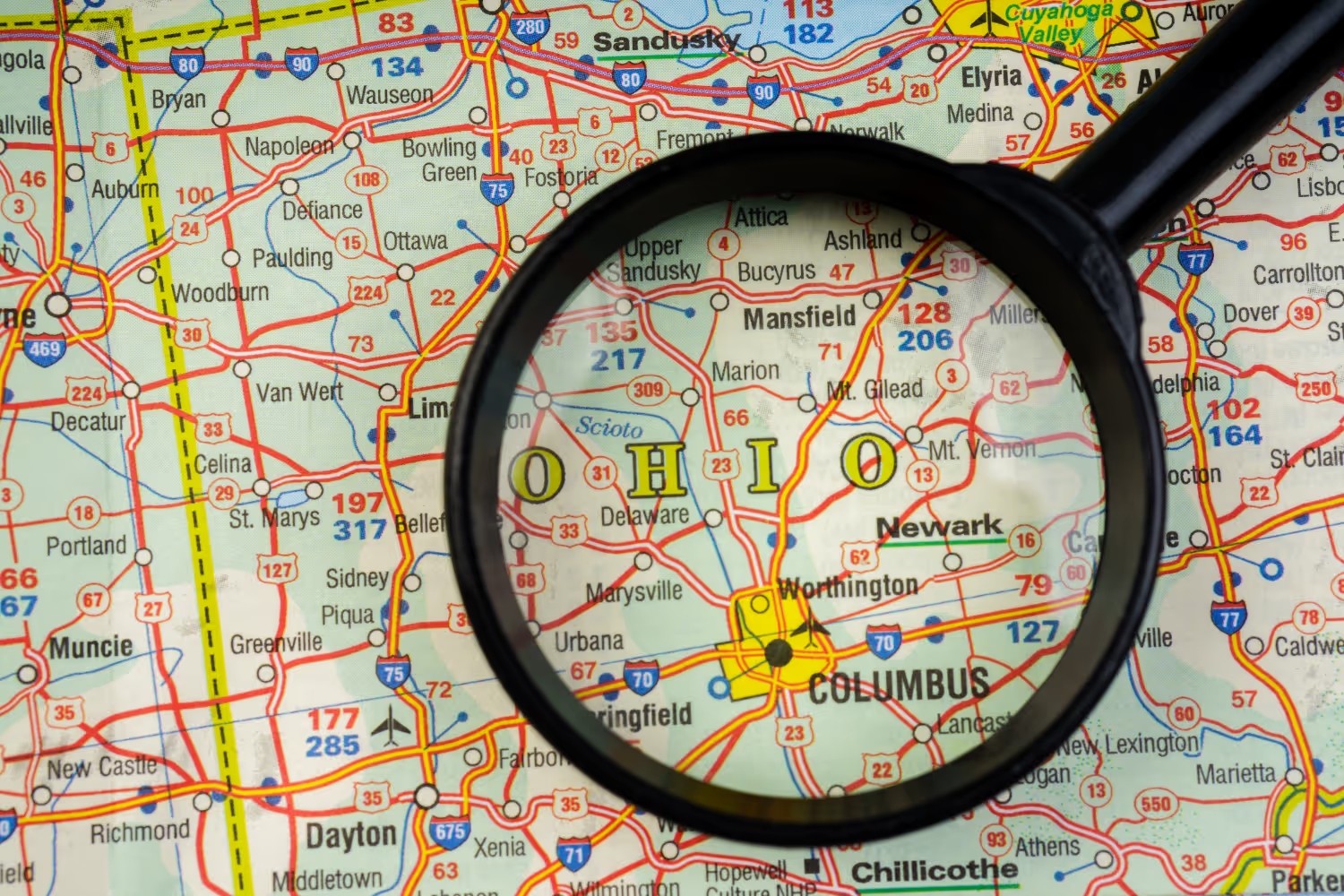
One of the scariest factors associated with human trafficking is that it can happen to anyone. It doesn't matter how old someone is, their ethnicity, or national origin.
Ohio's circumstances amplify the problem as it ranks as one of the top ten states for the number of human trafficking cases in the United States.
The situation may seem hopeless, especially when you take a closer look at the human trafficking statistics associated with Ohio. However, residents of the state are actively reporting suspected trafficking situations to the police and relevant hotlines.
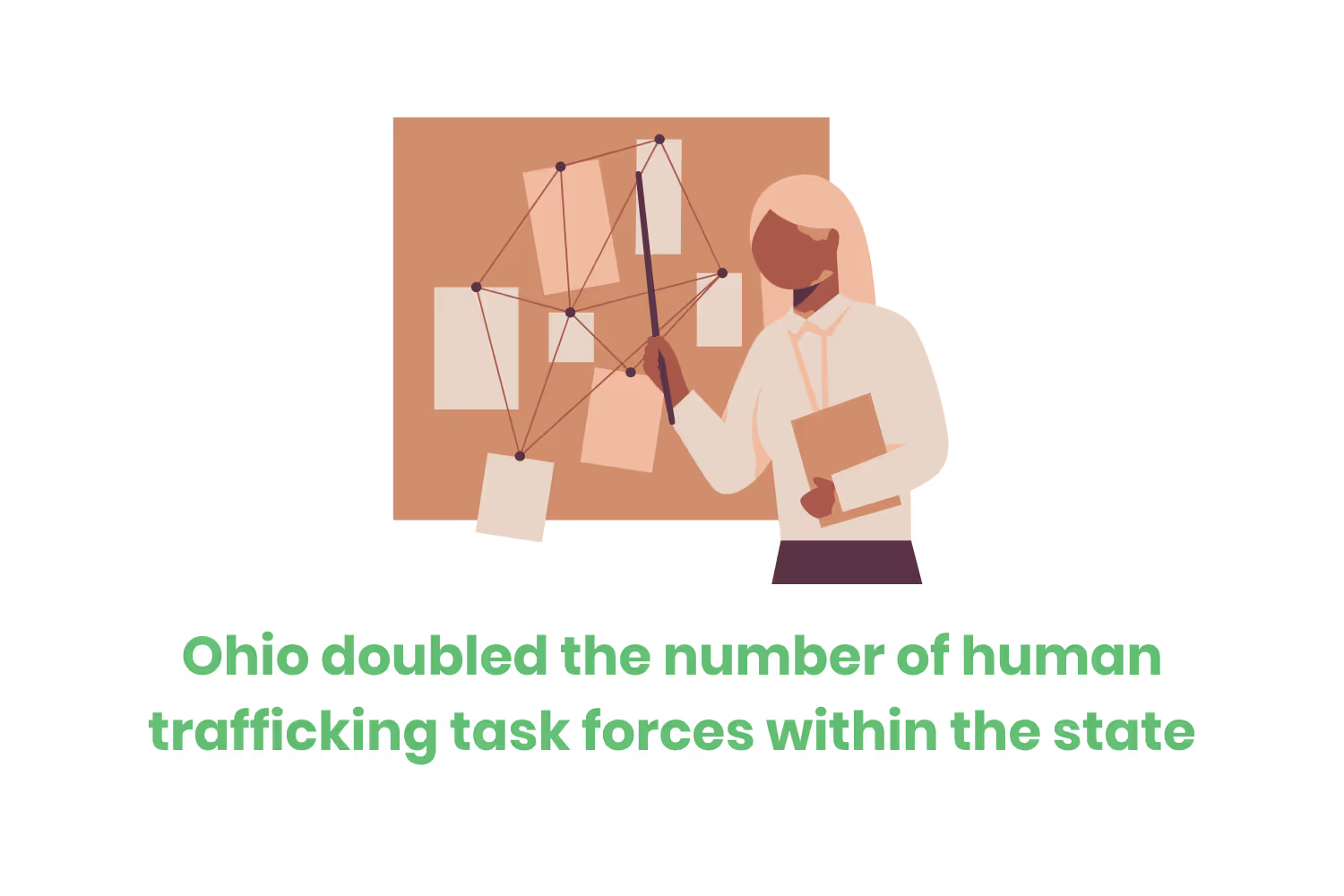
People perpetrating modern-day slavery are going to prison. Also, those who purchase the services of human trafficking victims are getting convicted.
Ohio doubled the number of human trafficking task forces within the state. This means that as time goes on, more victims will find their freedom and more abusers will go to prison.
To understand the full picture, you need to understand human trafficking-related events in Ohio over the last four years.
Definition of Human Trafficking in Ohio
Different organizations, both globally and domestically, define human trafficking in slightly different ways.
The United Nations defines human trafficking as…
"The act of recruitment, transportation, transfer, harboring or receipt of persons, utilizing a threat or use of force or other forms of coercion, of abduction, of fraud, of deception, of the abuse of power or a position of vulnerability or the giving or receiving of payments or benefits to achieve the consent of a person having control over another person, for the purpose of exploitation."
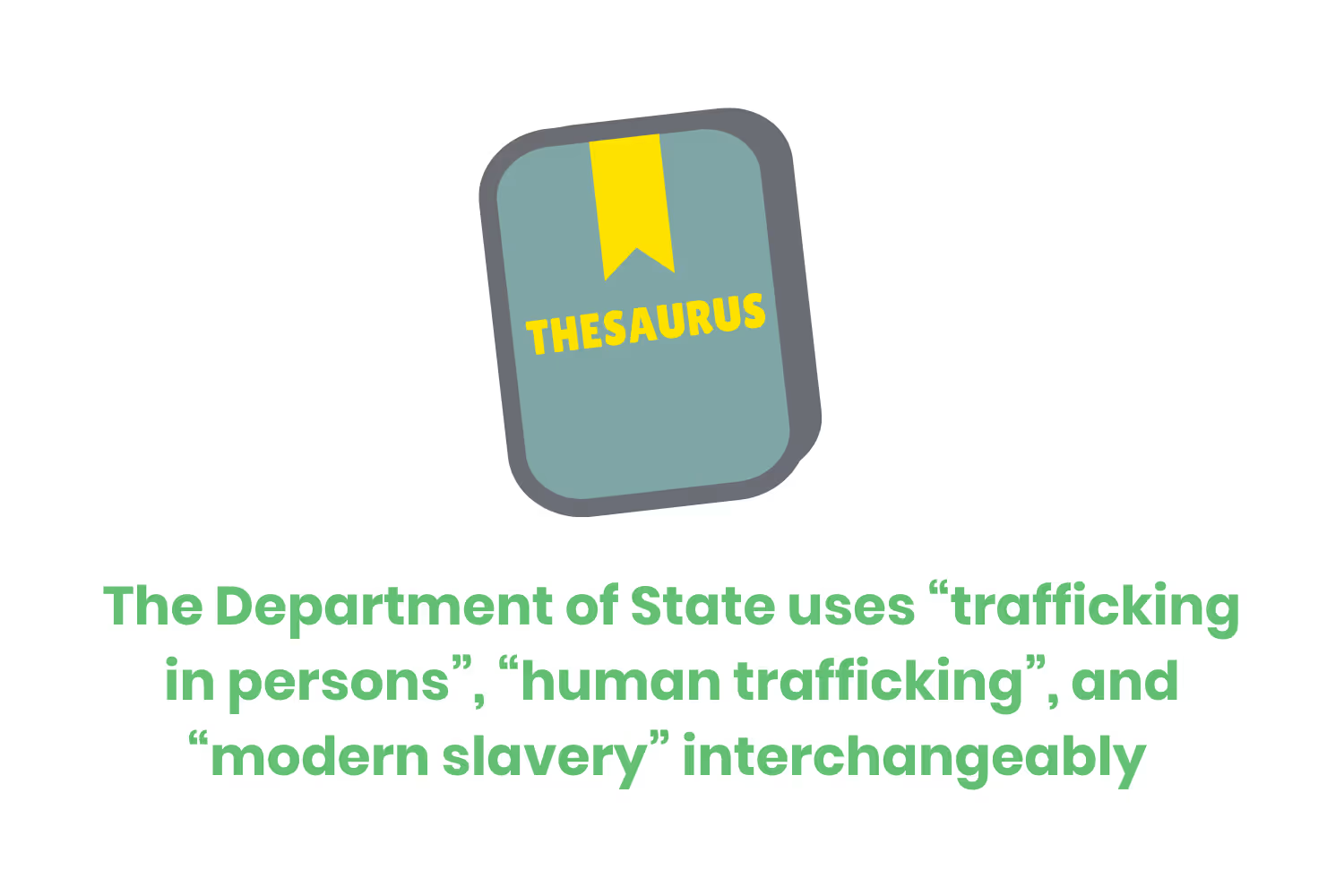
The U.S. Department of State uses the terms “trafficking in persons”, “human trafficking”, and “modern slavery” interchangeably when referring to human trafficking. According to the Department of State, these terms refer to…
"...A crime whereby traffickers exploit and profit at the expense of adults or children by compelling them to perform labor or engage in commercial sex. If the person used to perform in a commercial sex act is younger than 18, it is a crime regardless of whether there is any force, fraud, or coercion."
The federal definition in the U.S is slightly different. Federal law defines human trafficking as…
"A commercial sex act induced by force, fraud, or coercion, or in which the person induced to perform such act has not attained 18 years of age; or the recruitment, harboring, transportation, provision, or obtaining of a person for labor or services through the use of force, fraud, or coercion for the purpose of subjection to involuntary servitude, peonage, debt bondage, or slavery."
Ohio defines the trafficking in persons (meaning the act of human trafficking) in two separate categories. The state defines sex trafficking as…
“Any commercial sex act compelled by force, fraud, or coercion. Under federal law, any minor under the age of 18 induced into commercial sex is a victim of sex trafficking.”
The state’s definition of labor trafficking is…
“The recruitment, harboring, transportation, provision or obtaining of a person for labor or services, through the use of force, fraud or coercion for the purpose of subjection to involuntary servitude, debt bondage or slavery.”

How Ohio Stacks Up
As of June 2022, Ohio ranks fifth in the nation for human trafficking cases. However, Ohio’s rate of human trafficking is 3.84 victims per 100,000 state residents, putting Ohio at the fourth worst ratio in the nation. This victim-to-population ratio translated to 450 human trafficking cases in Ohio during the same year.
To make matters worse, Columbus ranked ninth as one of the worst cities in the United States for human trafficking.
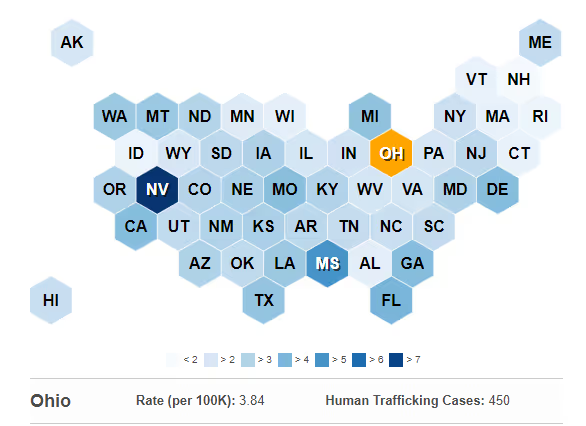
Ohio’s ratio is significantly higher than the national average of 2.82 victims per 100,000 citizens.
On the bright side, in 2019, Ohio ranked fifth as one of the top states for reported human trafficking cases. This improved in 2022 as Ohio currently ranks fourth in the U.S. for the number of reported human trafficking cases. Within Ohio, Mahoning and Trumbull Counties are two of the major reporting hotspots.
Reporting Human Trafficking in Ohio
If you see human trafficking, alert the police or a human trafficking hotline about the situation.
One such hotline is the National Human Trafficking Hotline (NHTH), an organization that works closely with service providers, law enforcement, and other professionals in each state.
When it comes to Ohio, the NHTH responds to human trafficking cases and forwards the information to agencies that can help the victims escape their situation. Therefore, the more Ohioans contact the hotline, the more opportunities there are to help victims and survivors.
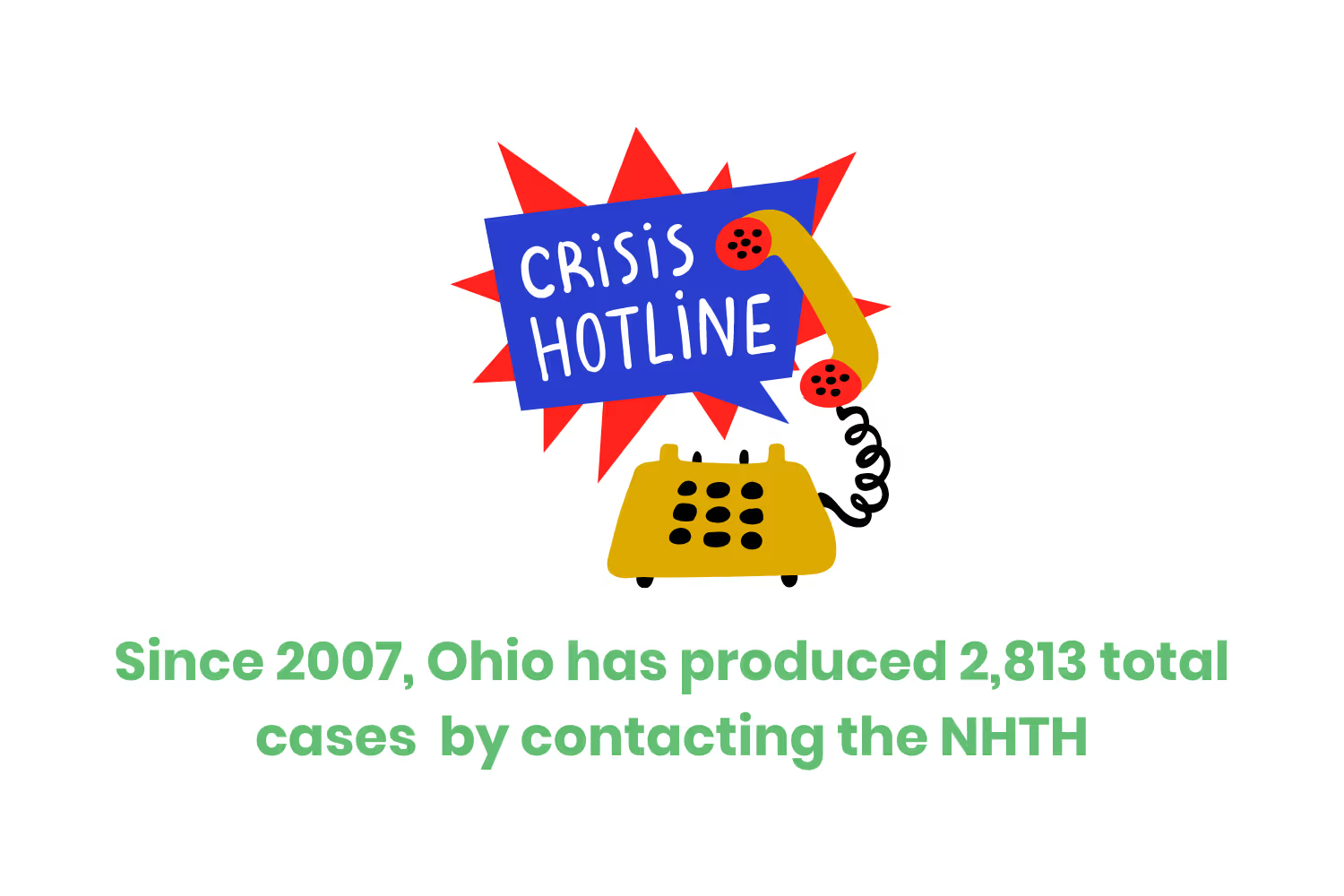
Since 2007, Ohio has produced 10,301 total NHTH contacts. These contacts correlated to 2,813 total cases over 13 years.
Incoming Signals
The NHTH keeps track of all substantive communications related to human trafficking each year. These communications are also known as “signals”.
Substantive signals do not include hang-ups, wrong numbers, missed signals, and any undetermined reasons for the contact. Substantive communications include…
- Phone Calls
- SMS
- Webchats
- Direct communication with hotline staff on the website's online chat feature
- Online Tip Reports
- A standardized form accessed from the website that allows someone to provide necessary details without directly interacting with hotline employees
- Emails
In 2020, the NHTH received a little over 1,000 substantive contacts.

These included…
- 808 phone calls
- 151 text messages
- 51 completed standardized online forms
- 59 emails
- 18 webchats
In turn, these contacts correlated to 310 human trafficking cases during that year.
Signalers
As you can probably guess, signalers notify the NHTH of a potential situation.
In 2020, Ohio produced the sixth-largest signal volume out of all 50 states, and Washington, D.C. This is good news because law enforcement has a better chance of catching criminals with these tips.
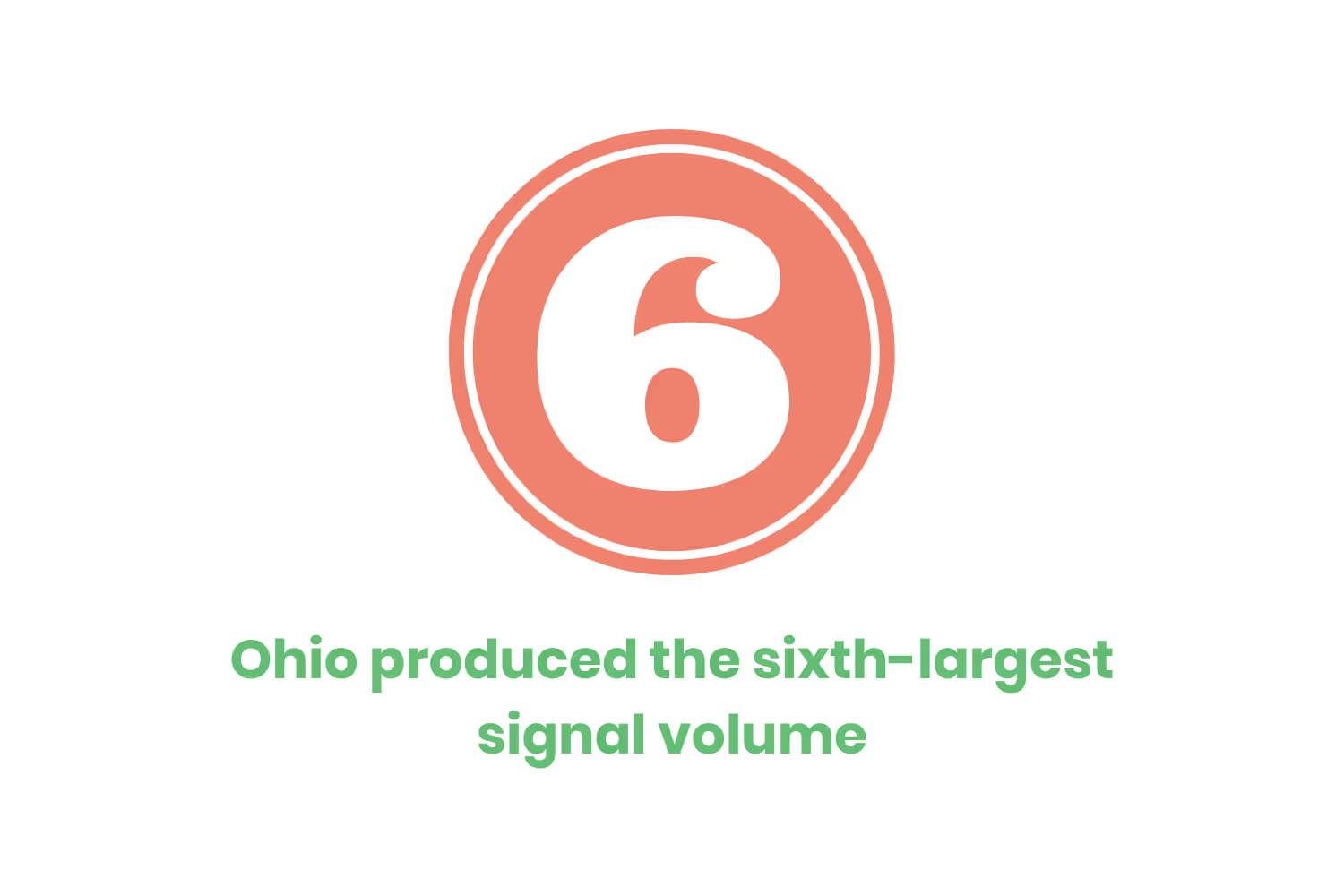
The NHTH classified the 2020 signalers into over 20 different groups and ranked them based on the number of signals produced by the categories. These signaler types include…
- Victim of trafficking
- 370 signals
- 34% of signals
- Community member
- 184 signals
- 17% of signals
- Non-government organization
- 118 signals
- 11% of signals
- Other
- 102 signals
- 9% of signals
- Victim of another crime
- 81 signals
- 7% of signals
- Family of a trafficking victim
- 46 signals
- 4% of signals
- Medical professional
- 42 signals
- 4% of signals
- Unspecified
- 25 signals
- 2% of signals
- Law enforcement
- 18 signals
- 2% of signals
- Government official
- 16 signals
- 1% of signals
- Mental health professional
- 14 signals
- 1% of signals
- Legal professional
- 12 signals
- 1% of signals
- Student
- 11 signals
- 1% of signals
- Friend of a trafficking victim
- 10 signals
- 1% of signals
- Educators or school personnel
- 10 signals
- 1% of signals
- Faith-based representative
- 9 signals
- 1% of signals
- Acquaintance of trafficker
- 5 signals
- <1% of signals
- Victim of labor exploitation
- 4 signals
- <1% of signals
- Business
- 4 signals
- <1% of signals
- Trucker
- 4 signals
- <1% of signals
Demographic Statistics
Traffickers look for vulnerabilities in potential victims. People who are emotionally susceptible, experiencing economic hardship, and lack a social safety net are prime targets for trafficking.
Runaways are at the greatest risk of becoming victims. Research shows that a runaway will encounter an exploiter within 48 hours of leaving home.
When it comes to figuring out what victims of human trafficking look like, we need to look at three aspects of their identities: gender, age, and citizenship.
White females between the ages of 21 and 29 comprise 98% of victims of sex trafficking within Ohio.
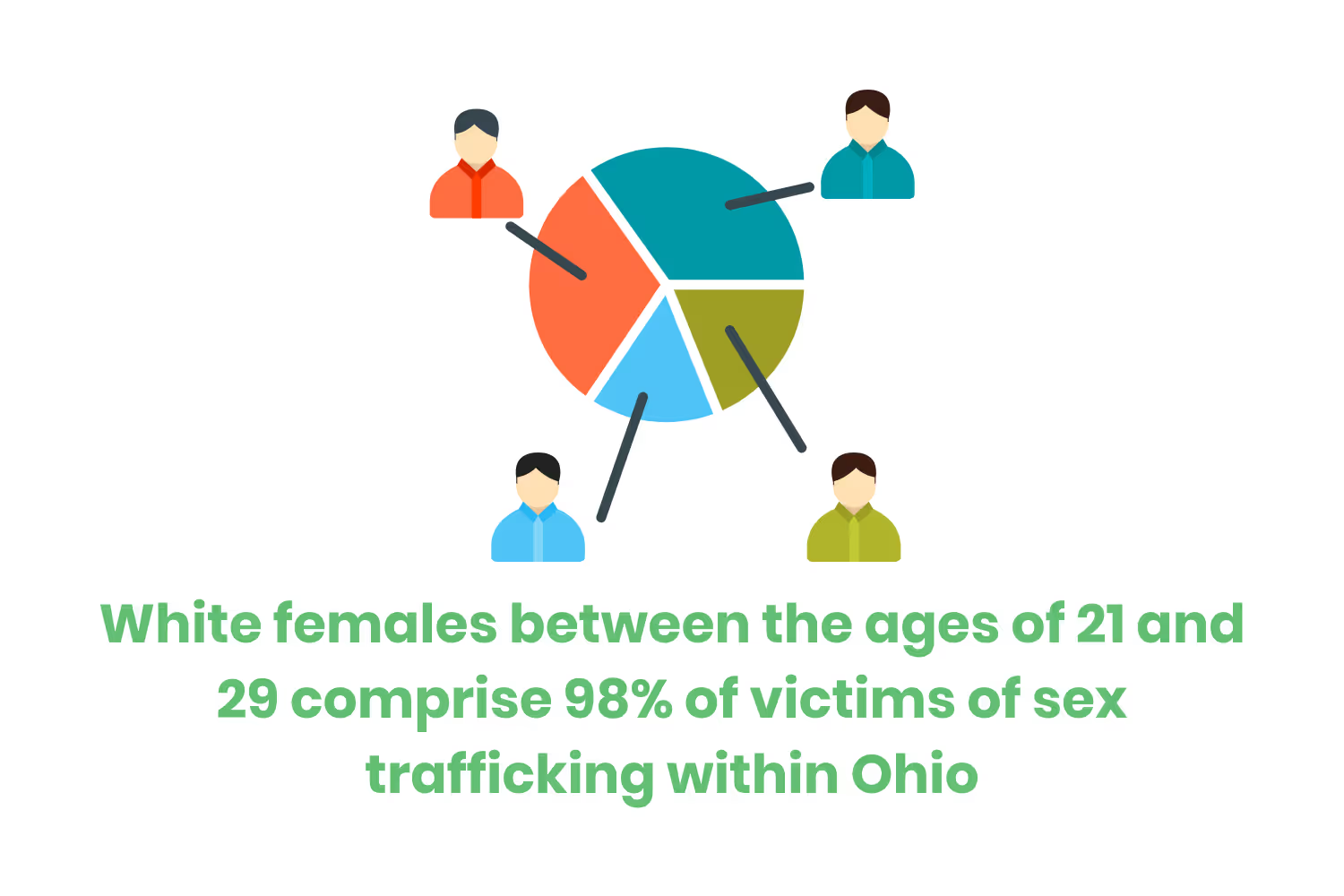
Data from the NHTH shows that the majority of victims and survivors are female. Out of the 310 identified cases in 2020, the gender breakdown includes…
- 266 female victims
- Roughly 86% of victims were female
- 39 male victims
- Roughly 10% of victims were male
- 3 victims of a gender minority
- Less than 1% of identified cases involved a victim of a gender minority
The NHTH distinguishes the age of victims into two classifications: adults and minors. According to their database, 212 victims in 2020 were adults. Another 77 victims were children.
Venue Trafficking Statistics
As I mentioned earlier, the NHTH received reports of 310 human trafficking cases in 2020.
The majority of these trafficking cases fall under sex trafficking. To be more specific, 241 reported cases were sex trafficking. Another 21 cases were labor trafficking.

Sometimes the signals do not specify the type of trafficking, leading to 45 unspecified trafficking cases. Other times, signals reveal that the victims are in a situation that is both sex and labor trafficking. This dual classification applied to three cases that year.
The 21 identified labor trafficking cases fall into a variety of industries. Top venues and industries for labor trafficking include…
- Domestic Work
- 6 cases
- 2% of total potential trafficking situations
- Unspecified industry
- 5 cases
- 2% of total potential trafficking situations
- Traveling Sales Crews
- 3 cases
- 1% of total potential trafficking situations
- Health Care
- <3 cases
- <1% of total potential trafficking situations
- Agriculture
- <3 cases
- <1% of total potential trafficking situations
- Retail/other small businesses
- <3 cases
- <1% of total potential trafficking situations
The 241 identified sex trafficking cases in Ohio also occurred in a variety of venues and industries. Unfortunately, 121 of these cases did not specify a venue. However, the specified venues include…
- Residence-based commercial sex
- 22 cases
- 7% of total potential trafficking situations
- Pornography
- 21 cases
- 7% of total potential trafficking situations
- Hotel/motel-based
- 20 cases
- 6% of total potential trafficking situations
- An online ad, venue unknown
- 17 cases
- 5% of total potential trafficking situations
- Other venues
- 16 cases
- 5% of total potential trafficking situations
- Illicit massage/spa business
- 10 cases
- 3% of total potential trafficking situations
- Street-based
- 8 cases
- 3% of total potential trafficking situations
Human Trafficking by State Sources
The state of Ohio passed legislation in 2012 to guide the identification process of human trafficking victims. Ohio legislators passed additional laws to guide the prosecution of traffickers and purchasers of commercial sex from minors.
Many agencies in Ohio have human trafficking awareness and identification initiatives. Based on these activities, six agencies identified potential or confirmed human trafficking victims during 2020.
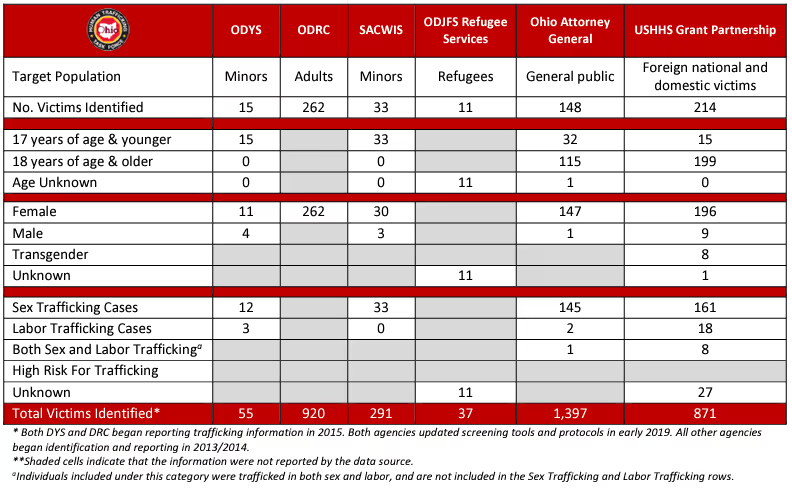
I must mention the numbers in the image above do not signify the total number of victims in Ohio. There is a good chance that several agencies identified the same individual.
The data from the six agencies gives some insight into the reality of human trafficking in Ohio. The majority of identified victims are adults and females. The majority of victims endured sex trafficking-related situations.
The organizations found very few instances of labor trafficking or a combination of labor trafficking and sex trafficking. They identified very few males and transgender individuals as well.
The Ohio Department of Youth Services (ODYS) started screening adolescents in 2014. The agency has since identified 55 victims. In 2020, the agency screened 287 Ohioans for trafficking and identified 15 victims.
The Ohio Department of Rehabilitation and Correction (ODRC) began its screenings in 2014. They specifically screen all inmates at reception for indicators. The inmates are also screened at various touch points throughout their imprisonment. The department screened 15,256 people in 2020. From these screenings, they identified 262 individuals as victims of human trafficking.

The Statewide Automated Child Welfare Information System (SACWIS) screens children in 88 county public children's services agencies. SACWIS started reporting human trafficking cases in 2008. They assist the Ohio Department of Job and Family Services staff members to manage workloads and provide current data. In 2020, the organization reported 33 substantiated cases of trafficking.
Since 2014, SACWIS identified 291 minors caught in human trafficking situations.
The Ohio Department of Job and Family Services (ODJFS Refugee Services) began reporting human trafficking cases in 2008. They operate as part of a national and international effort to assist people displaced from their countries. This includes trafficking victims stuck in foreign countries because of their abusers. In 2020, the organization served 11 individuals identified as victims of human trafficking.
The State Refugee Coordinator identified 37 individuals since 2014.
The Ohio Attorney General’s Office - Human Trafficking Initiative mainly collects data. Ohio law enforcement needs to report the number of identified human trafficking cases annually to the General’s Office according to the Safe Harbor Law enacted in 2012. They collect data related to human trafficking investigations, arrests, prosecutions, and convictions of traffickers.
In 2020, law enforcement identified 148 potential and confirmed victims of human trafficking. Since 2014, the Office identified a total of 1,397 victims in the general public.
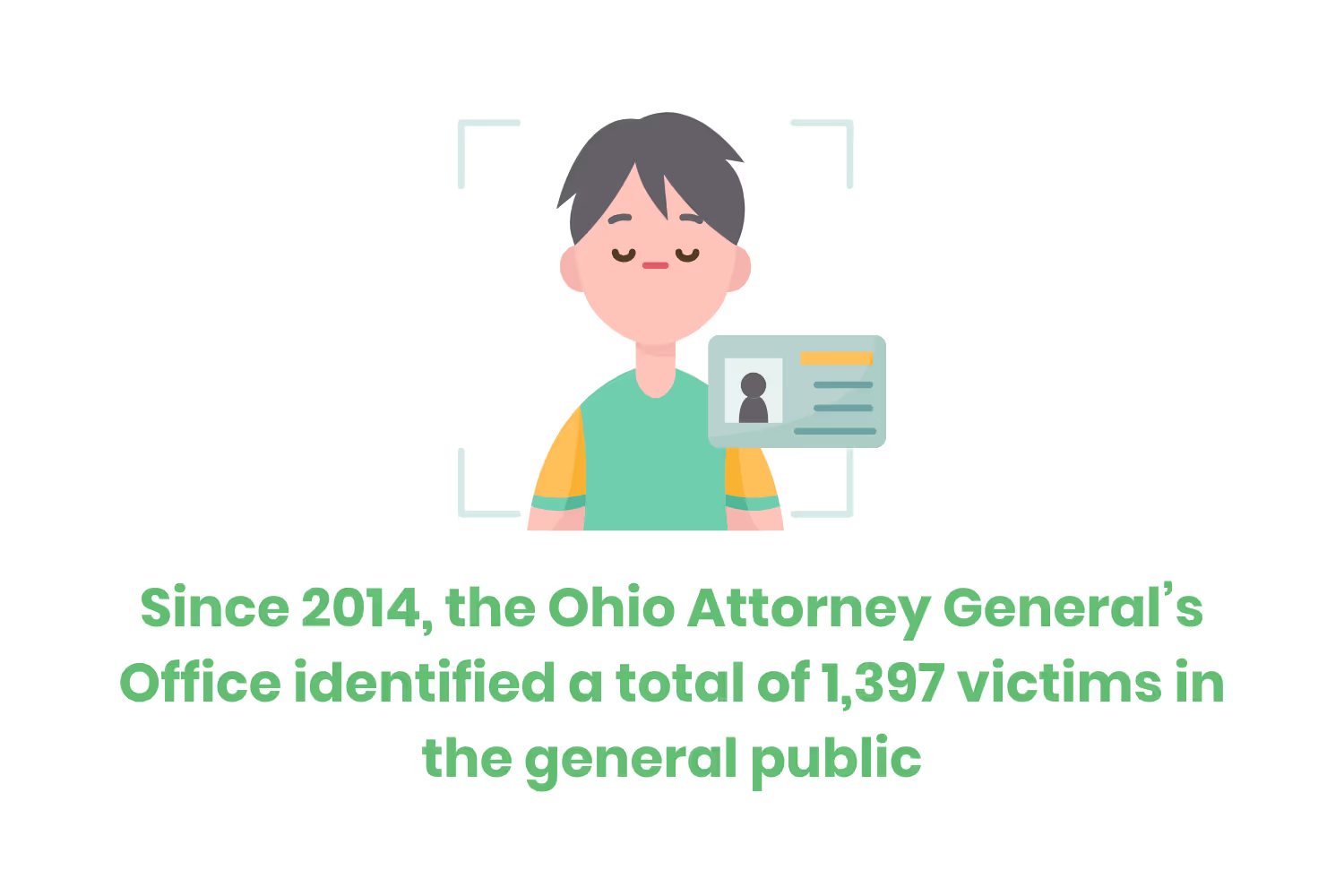
The HHS Grant Partnership assists foreign national and domestic human trafficking victims in Ohio. Organizations and local outreach partners benefiting from the grant identified 214 survivors of human trafficking in 2020.
Between 2014 and 2020, the organization identified a total of 871 victims in the general public.
Cases and Arrests
The 2020 Federal Human Trafficking Report shed some light on the prevalence of modern-day slavery in Ohio compared to other states during that time. The report separates Ohio into two districts: northern and southern.
Ohioan federal prosecutors charged eight new criminal human trafficking cases that year. Five of these cases were in the northern district and the other three were in the southern district. This is an improvement over the five new criminal cases from the year before. All eight of the cases dealt with sex trafficking.
There was also one new civil human trafficking case.
Federal courts in Ohio handled 35 active criminal human trafficking cases. 97% of the cases were sex trafficking and the other 3% dealt with forced labor.

There were two convicted defendants that year. This is low compared to the eight convinced defendants the year before. This is likely because the court proceedings could not occur due to the COVID-19 pandemic.
One conviction occurred in the northern district and the other in the southern district. The courts found one defendant guilty of sex trafficking and the other guilty of forced labor. Only one of these convicted defenders had to pay restitution to the victims.
It is important to note that there were four sex trafficking cases charged outside of the Trafficking Victims Protection Act. This means that four people suspected of trafficking a person did go to jail, but not necessarily for the crime of trafficking. Either way, they can’t continue the abuse behind bars, so I’ll consider it a “win” for the public.
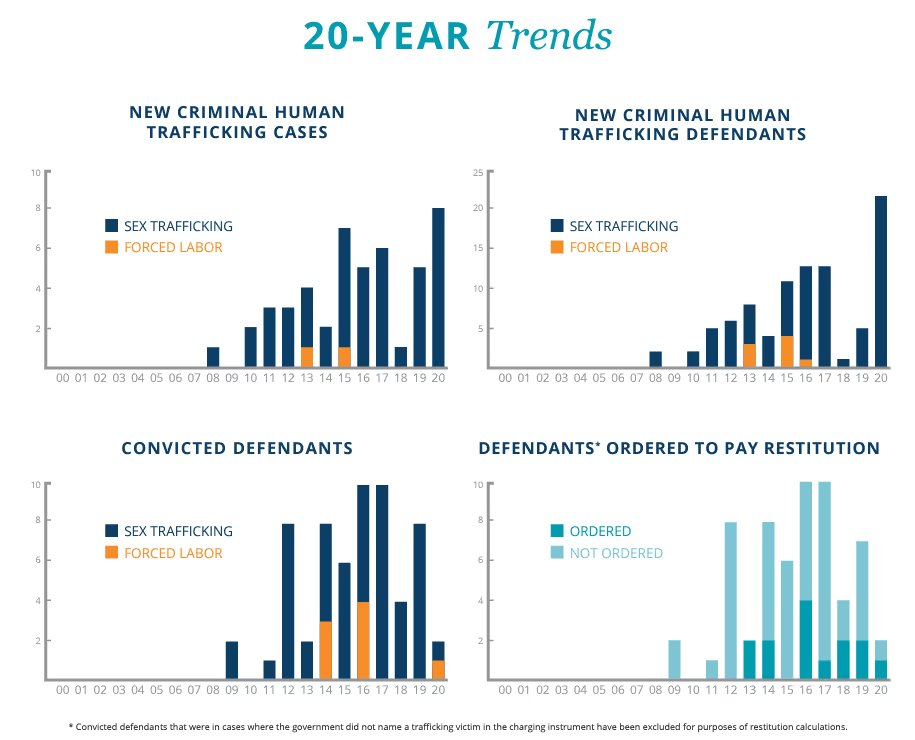
While these cases and convictions occurred, the Ohio Organized Crime Investigations Commission (OOCIC) had three human trafficking task forces operating in the state:
- The Central Ohio Human Trafficking Task Force
- The Columbus Division of Police is the leading agency
- The Cuyahoga Regional Human Trafficking Task Force
- Led by the Cuyahoga County Sheriff’s Office
- Mahoning Valley Human Trafficking Task Force
- Led by the Mahoning County Sheriff's Department
This means that all of the cases and convictions happened under the watchful eye of three police departments. In 2021, the OOCIC created three new human trafficking task forces:
- The Miami Valley Human trafficking Task Force
- Led by the Montgomery County Sheriff's Office
- The Summit County Human Trafficking Task Force
- Led by the Summit County Sheriff's Office
- And the Southeastern Ohio Human Trafficking Task Force
- Led by the Washington County Sheriff’s Office
Now that Ohio doubled the manpower to combat human trafficking within the state, we should see an increase in criminal and civil trafficking cases, the number of defendants accused of trafficking a person, and convicted defendants. With more investigative power, more future defendants may need to pay restitution to their victims.
The six task forces active in 2021 received 627 human trafficking tips. In turn, this led to 621 victim interviews and referrals for services. With the help of these tips made by the public, the task forces made many cases and arrests throughout the year.
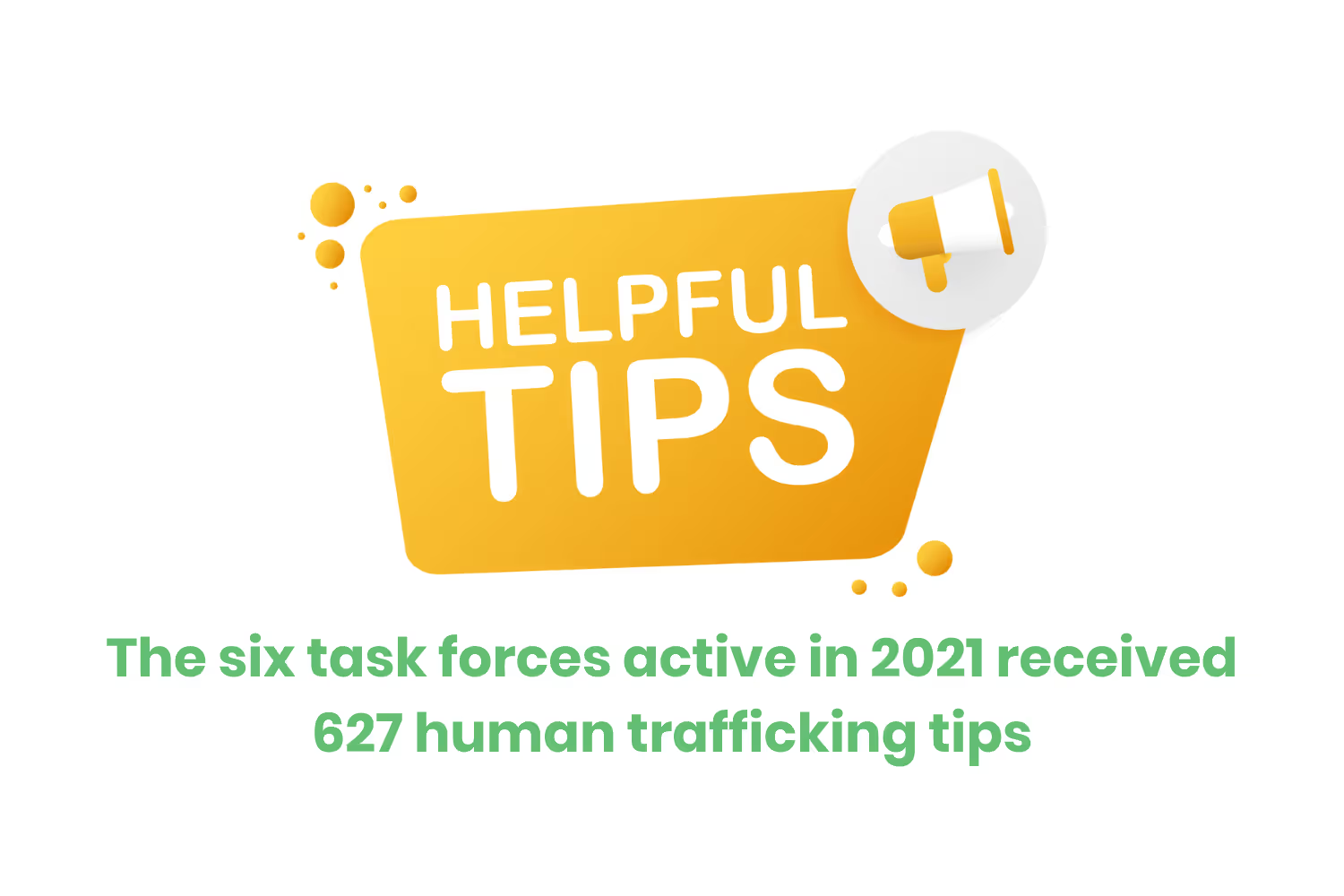
In January and February of 2021, most of the task force completed the Forensic Experiential Trauma Interview. This is an intensive interviewing program that uses the neurobiology of trauma and memory treacle to help investigators better interview victims. This program also helps with interviewing witnesses of human trafficking.
The Mahoning Valley Task force arrested a man in Youngstown for human trafficking in February 2021. A federal grand jury indicted the man in May on charges related to child sexual abuse and enticing a minor.
In April 2021, law enforcement and social services identified 53 victims as a result of Operation 614. In turn, they arrested 93 individuals.
In June 2021, the Central Ohio Task Force investigated a case that led to the indictment of an individual on 20 felony counts. The grand jury found the man guilty of trafficking in persons along with various drugs and weapons charges.
The Southeastern Ohio Task force arrested a Salem man in July 2021. Authorities discovered a minor from West Virginia in the man’s car during a traffic stop. Further investigation uncovered that the man engaged in sexual activity with the minor. The perpetrator was later indicted by a federal grand jury.
In October 2021, a statewide sting took place, called Operation Ohio Knows. The sting led to the arrests of 161 people seeking to purchase sexual favors from trafficking victims. Some of the arrests included a city council member, a teacher, a firefighter, a professor, and a pilot.

Two separate events occurred in November 2021.
In the first notable event, the Central Ohio Task Force and the Fairfield County Sheriff's Office conducted two stings targeting buyers of sexual favors from victims. As a result, police arrested 23 males.
In the second notable event, Lorain County had its first human trafficking indictment. The courts indicted the man on 54 counts. The police recovered nine victims during the investigation.
Conclusion
Based on the human trafficking statistics in Ohio above, the situation is grim.
Ohio is one of the worst states for human trafficking, both for the number of victims and the state’s victim-to-population ratio.
To make matters worse, Ohio’s capital, Columbus, is one of the top ten worst cities for trafficking people.
Luckily, the state is taking action. The number of task forces addressing human trafficking doubled thanks to new legislation. Police departments are working together across county lines to capture perpetrators and third parties benefiting from slavery.
Based on the arrests made in 2021, Ohio is making progress. It is safe to say that the rate of freed victims and convicted perpetrators will increase. This may make Ohio look worse since the number of victims and trafficking cases will increase. However, This means less trafficking will hide under the radar in the future.
As a citizen, one of the best things you can do is to call in suspicious situations. Even if you might be wrong, you could help save a life. The more tips given to the National Human Trafficking Hotline and the police, the more chances victims have of returning to their families.
If you see something, say something.
Emphasize your product's unique features or benefits to differentiate it from competitors
In nec dictum adipiscing pharetra enim etiam scelerisque dolor purus ipsum egestas cursus vulputate arcu egestas ut eu sed mollis consectetur mattis pharetra curabitur et maecenas in mattis fames consectetur ipsum quis risus mauris aliquam ornare nisl purus at ipsum nulla accumsan consectetur vestibulum suspendisse aliquam condimentum scelerisque lacinia pellentesque vestibulum condimentum turpis ligula pharetra dictum sapien facilisis sapien at sagittis et cursus congue.
- Pharetra curabitur et maecenas in mattis fames consectetur ipsum quis risus.
- Justo urna nisi auctor consequat consectetur dolor lectus blandit.
- Eget egestas volutpat lacinia vestibulum vitae mattis hendrerit.
- Ornare elit odio tellus orci bibendum dictum id sem congue enim amet diam.
Incorporate statistics or specific numbers to highlight the effectiveness or popularity of your offering
Convallis pellentesque ullamcorper sapien sed tristique fermentum proin amet quam tincidunt feugiat vitae neque quisque odio ut pellentesque ac mauris eget lectus. Pretium arcu turpis lacus sapien sit at eu sapien duis magna nunc nibh nam non ut nibh ultrices ultrices elementum egestas enim nisl sed cursus pellentesque sit dignissim enim euismod sit et convallis sed pelis viverra quam at nisl sit pharetra enim nisl nec vestibulum posuere in volutpat sed blandit neque risus.

Use time-sensitive language to encourage immediate action, such as "Limited Time Offer
Feugiat vitae neque quisque odio ut pellentesque ac mauris eget lectus. Pretium arcu turpis lacus sapien sit at eu sapien duis magna nunc nibh nam non ut nibh ultrices ultrices elementum egestas enim nisl sed cursus pellentesque sit dignissim enim euismod sit et convallis sed pelis viverra quam at nisl sit pharetra enim nisl nec vestibulum posuere in volutpat sed blandit neque risus.
- Pharetra curabitur et maecenas in mattis fames consectetur ipsum quis risus.
- Justo urna nisi auctor consequat consectetur dolor lectus blandit.
- Eget egestas volutpat lacinia vestibulum vitae mattis hendrerit.
- Ornare elit odio tellus orci bibendum dictum id sem congue enim amet diam.
Address customer pain points directly by showing how your product solves their problems
Feugiat vitae neque quisque odio ut pellentesque ac mauris eget lectus. Pretium arcu turpis lacus sapien sit at eu sapien duis magna nunc nibh nam non ut nibh ultrices ultrices elementum egestas enim nisl sed cursus pellentesque sit dignissim enim euismod sit et convallis sed pelis viverra quam at nisl sit pharetra enim nisl nec vestibulum posuere in volutpat sed blandit neque risus.
Vel etiam vel amet aenean eget in habitasse nunc duis tellus sem turpis risus aliquam ac volutpat tellus eu faucibus ullamcorper.
Tailor titles to your ideal customer segment using phrases like "Designed for Busy Professionals
Sed pretium id nibh id sit felis vitae volutpat volutpat adipiscing at sodales neque lectus mi phasellus commodo at elit suspendisse ornare faucibus lectus purus viverra in nec aliquet commodo et sed sed nisi tempor mi pellentesque arcu viverra pretium duis enim vulputate dignissim etiam ultrices vitae neque urna proin nibh diam turpis augue lacus.




